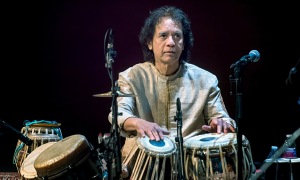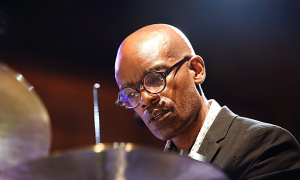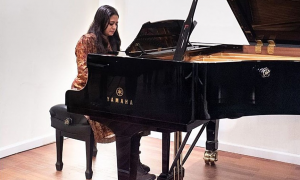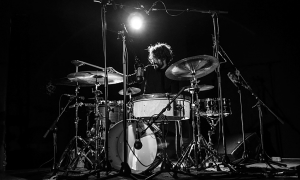Home » Jazz Articles » Under the Radar » A Different Drummer, Pt. 8: Ustad Zakir Hussain Talks Tabla
A Different Drummer, Pt. 8: Ustad Zakir Hussain Talks Tabla

Courtesy Dave Kaufman
Working with Mr. [John] Handy was a most enlightening and precious time for me; he prepared me for my later encounters with my mentors John Mclaughlin and Mickey Hart.
—Zakir Hussain
Origins of the Tabla
The twin hand drum was developed in its current form about 300 years ago on the Indian subcontinent but the roots of the tabla may date to pre-Muslim, Arabia. The name comes from "tabl," the Arabic word for drum, and temple carvings of tabla-like double-hand drums date to 500 BCE. Tabla is commonly used in India, Bangladesh, Pakistan, Nepal, Afghanistan, and Sri Lanka. The drum's use crosses most genres in that region; it is used in classical, folk, film, religious, popular, and dance music.The tabla consists of two drums, the bāyāñ (left) and the dāyāñ (right) and they are different sizes and shapes. The dāyāñ is used for treble and the bayan for producing bass. Both are fastened with hoops, twine and dowels are used for tuning the drums. The bāyāñ bears a resemblance to a small kettle drum at about ten inches in height. Its playing surface is approximately five inches but can vary slightly. Traditionally, the bāyāñ is made from clay or metals including copper, or bronze with a goat skin head. The dāyāñ is made of wood, preferably Sheesham, or Indian Rosewood. The right drum is ten-and-a-half inches high, with seven to eight-and-a-quarter inches playing surface. Both drums sit on a cushion and are held in place by a padded ring. The head of each drum has a circle of paste at the center called the syahi. Made of flour, water, and iron filings; the weight of the syahi modifies the natural overtones of the drums.
The tabla is considered the hardest percussion instrument to learn. On the subcontinent, it is referred to as the "queen of drums." Tabla experts of the region believe that a musician proficient on the tabla can play any other drum or percussion instrument in the world. The playing method encompasses wide-ranging use of the fingers and palms in numerous arrangements to create a diversity of sounds and rhythms. In James Blades' authoritative percussion reference, Percussion Instruments and Their History (Faber & Faber Ltd., 1970), the musician-scholar relates that famed English composer Imogen Holst studied with a tabla master but found the instrument too problematic to learn satisfactorily.
The Tabla Goes West
To a large extent, The Beatles, and George Harrison, in particular, popularized the sound of the tabla in Western popular music. The Beatles Sgt. Pepper's Lonely Hearts Club Band (Capital Records, 1967) included Harrison's composition "Within You Without You." The song was not a proper Beatles tune as the lead guitarist recorded it with the group Asian Music Circle. From that collective, Harrison brought in Anna Joshi and Amrit Gajjar on dilruba (a bowed instrument), Buddhadev Kansara on tamboura (a long-necked, string instrument), and tabla player Amiya Dasgupta. Harrison studied sitar under Ravi Shankar and was first inspired to incorporate Indian instrumentation on "Love You To" from Revolver (Capital Records, 1966) and he continued to feature East/West fusions in his solo work.The The Rolling Stones, Beggar's Banquet (Decca, 1968) featured Charlie Watts playing tabla on the country ballad "Factory Girl." More than three decades later, Watts would take up the instrument for the Charlie Watts/Jim Keltner Project (Promotone BV, 2000). The album is a tribute to jazz percussionists including Shelly Manne, Art Blakey, Roy Haynes, Max Roach, and Billy Higgins. Though tabla use in popular Western music has been sporadic, it has run the gamut of sub-genres; the instrument makes appearances with British indie rockers Cornershop, Metallica ("Wherever I May Roam"), and Paul Simon's So Beautiful Or So What (Hear Music, 2011).
Tabla in Jazz
Midwest American jazz violinist Leon Abbey toured Mumbai (then, Bombay), India in 1935 with his orchestra. The impact was instantaneous and deep. Abbey was hired on to a hotel residency and jazz was in India to stay. More often than not, the later experimentation that led to the fusion of musical cultures was initiated by Indian improvisers. The album Jazz Raga (Impulse!, 1966) was considered a cross-genre breakthrough in the West. But the album came by way of Hungarian guitarist/sitarist Gabor Szabo and an American rhythm section. The influences owed more to gypsy, jazz, and Far Eastern music. Szabo played sitar but more in a traditional guitar style. Jazz Meets India (SABA, 1967) from the Dewan Motihar Trio featured Western jazz artists Manfred Schoof, Barney Wilen, and Irene Schweizer. While the album was a seamless transition of philosophies, East and West stayed in their respective lanes. Jazz Meets India is beautifully performed by the Indian trio of sitar, tambura, and tabla, and a piano jazz trio leaning toward free playing. Ravi Shankar was on a U.S. tour in the early 1960s when he met John Coltrane. Shankar's The Sounds of India (Columbia, 1957) was the first major-label release of Indian music in the U.S. and featured Shankar on sitar, Chatur Lal on tabla, and N.C. Mullick on tambura. All three were well known on the sub-continent but not in the West. Coltrane however, was well aware—and appreciative—of Shankar's music and had been casually tinkering with elements of Indian Classical music. The two became friends for life but it does not appear that they had ever played together. Shankar had preceded Coltrane in the experimental fusion with Improvisations and Theme from Pather Panchali (World Pacific Records, 1962). The effective title track featured bassist Gary Peacock and saxophonist Bud Shank.Indian multi-instrumentalist and composer John Mayer (1930-2004) and Jamaican alto saxophonist Joe Harriott formed the first Indian-jazz fusion ensemble in the mid-1960s under the banner of the Joe Harriott Double Quintet. The billing was more equitable on two subsequent albums, placing Mayer's name at the top. The group was global and included Canadian Kenny Wheeler on trumpet, Scottish pianist Pat Smythe, and English drummer Alan Ganley. The Indian musicians were Diwan Motihar on sitar, Chandrahas Paigankar on tambura, and Keshav Sathe on tabla. The Double Quintet first released the ground-breaking Indo-Jazz Suite (Columbia, 1966). Critics were far from unanimous in their praise of Indo-Jazz Suite but that may be partially due to an inability to easily describe and categorize the music. The album remains a standard for Indian-jazz fusion recordings more than a half-century later.
Badal Roy was a tabla player from East Pakistan who moved to New York City in 1968 to complete a Ph.D. in statistics. Guitarist John McLaughlin discovered Roy playing in a Manhattan restaurant and signed him to play on My Goal's Beyond (Douglas, 1971) where the tabalchi joined Charlie Haden, Dave Liebman, and Airto Moreira. Roy and the sitarist Khalil Balakrishna sat in at the Village Gate where Miles Davis was playing, resulting in their appearance on Davis' On the Corner (Columbia, 1972) and appeared on two later Davis albums. Roy later recorded with Bill Laswell and Pharoah Sanders. He appeared on Ornette Coleman's Tone Dialing (Verve, 1995).
Badal Roy was not the only tabla artist discovered by John McLaughlin. Trilok Gurtu was part of the guitarist's trio in 1994 and featured on McLaughlin's Molom (A Legend Of Mongolia) (Verve, 1995). The album is a soundtrack collection of McLaughlin compositions and traditional Mongolian songs. Gurtu also recorded with Pharoah Sanders and Jan Garbarek. Egyptian multi-percussionist and composer Hossam Ramzy brought the tabla to a wide variety of musical settings. As a solo artist, he was one of the top-selling Egyptian artists with a platinum recording and a number-one hit on the dance music charts. His international collaborations included projects with many global artists such as Peter Gabriel, ex Led Zeppelin's Jimmy Page and Robert Plant, Luciano Pavarotti and Jay Z. Ramzy's foray into jazz came early. Moving to England in 1975, Ramzy later connected with Carla Bley's colleague, Andy Sheppard and jazz pianist/percussionist Geoff Williams. Ramzy, who died of heart failure in 2019, regularly returned to his native Egyptian dance music but made noteworthy contributions to jazz until the end of his career. He recorded with French drummer Manu Katche and Billy Cobham as well as on Chick Corea's The Ultimate Adventure (Concord, 2006). Ramzy's jazz highlight came on the award-nominated Rock The Tabla (ARC, 2011) where he plays the Egyptian tabla (darbuka). The single-head, goblet-shaped drum looks and sounds different than the tabla but may be a link with the Indian instrument. Some ethnomusicologists believe that a darbuka-related instrument—the pakhawaj—may have been cut in half to form the two-drum tabla.
In the years since Coltrane became interested in Indian music, a generation of musicians has grown up in the U.S. and Britain knowing more about Indian music. The current Indian-Jazz fusion scene includes some of the best tabla players in music. BBC Radio named Anuradha Pal one of the "Five prominent women musicians of India" in 1991. Her incorporation of jazz, Latin, and Indian classical music is a unique hybrid. She studied with Alla Rakha and Zakir Hussain and her all-women band released the highly acclaimed Anuradha Pal's Recharge Plus (Sur Aur Saaz, 2014). Pal has been an artist-in-residence at the New England Conservatory and has conducted workshops at Harvard and M.I.T.
The Brooklyn Raga Massive is a large raga-jazz ensemble of visionary musicians, whose roots vary widely. Included on the roster are Andrew Shantz from the metal and jazz worlds, classical tanpura player Mari Tanaka, tabla/percussionist Sameer Gupta, and raga/blues sitar musician Saraswathi Ranganathan. Jazz artists Gwen Laster and Dan Weiss, are in the rotation as well. Weiss played tabla on Rudresh Mahanthappa's album Apti (Innova, 2008). Coltrane Raga Tribute (Raga Music, 2017), one of the collective's five albums, brings the fusion full circle putting a classical Indian spin on both John Coltrane and Alice Coltrane compositions.
Zakir Hussain
Born in 1951 in Mumbai, Zakir Hussain is the most renowned tabla player in the world, as was his father Ustad Allah Rakha, before him. Two decades beyond Allah Rakha's passing, Hussain continues to have strong spiritual ties to his mentor. A child prodigy, he was performing in concerts before he was in his teens and touring in the U.S. in his twenties. His two brothers, Taufiq Qureshi and Fazal Qureshi, are also noted percussionists. Hussain earned a Ph.D. in music from the University of Washington. He has won numerous national awards in his native country, a National Endowment for the Arts award in the U.S., and two Grammy Awards. In 2005, he was named an Old Dominion Fellow by the Humanities Council at Princeton University, where he was a music professor.Hussain sat in with George Harrison, and the Grateful Dead; his first recording as a co-leader was with the Dead's drummer Mickey Hart on Rolling Thunder (Warner Bros., 1972). Shortly afterward he began recording with jazz artists beginning with John McLaughlin and then with saxophonist John Handy. Their second collaboration, Hard Work (ABC Impulse!, 1976) brought Hussain recognition in Western jazz. Hussain went on to record with Herbie Hancock, Tony Williams, Pat Martino, Pharoah Sanders, Charles Lloyd, Bela Fleck, Dave Holland Jan Garbarek, and Chris Potter. He has continued to record with McLaughlin and Hart throughout his career. This interview was conducted via email in June 2022.
All About Jazz: Given your lineage, can we assume that you began studying tabla at a very early age?
Zakir Hussain: The question in itself is the answer. The age-old tradition all over the world has always been that the son follows his father's trade, till recent time this has been the case with some exceptions. I was no different.
AAJ: The London-based percussionist/writer Gideon Waxman suggests that tabla is mostly taught verbally instead of through notation. Can you explain that process?
ZH: Most of the masters were uneducated so they could not document the repertoire, verbally passing on the info was the only way, much was lost over time but what remained was a solid quantity of the ancient repertoire. This process also helped to sharpen the memory intake of the student and built confidence in the disciple to tackle the process of learning to improvise.
AAJ: Tabla artists such as yourself, your father Alla Rakha, and Bickram Ghosh, bridged the gap between Carnatic music of South India and Hindustani music of the North. Beyond the Indian Sub-Continent, the instrument has been popularized in several genres. Ravi Shankar's sitar and George Harrison's music gave much of the Western world their first experience with the Indian/Western hybrid. How would you describe the development of that South Asian-Western fusion over the decades?
ZH: You must not forget several great masters who were my father Allarakha's contemporaries, Pandit Kishan Maharaj, Pandit Samta Prasad who along with him made the first inroads in crossing the boundaries and establishing a dialogue between their southern brethren. Myself, Shankar Ghosh Ji, Swapan Chaudhuri, Anindo Chatterji, Lateef Ahmed Khan, Shafaat Ahmed Khan to name a few were engaged in this dialogue much before the present generation of tabla players arrived to continue the process. Much is yet to be done. We have only just scratched the surface, there is a lot of learning that needs to yet take place on both sides to have an in-depth meaningful, and respectful conversation.
AAJ: Your work with George Harrison, and your long association with Mickey Hart of the Grateful Dead, are acclaimed. Less well-known (in the U.S.) is your contribution to John Handy's Hard Work (Verve, 1976) blending the tabla seamlessly in a jazz/blues setting. How did you become involved in that project?
ZH: My first non-Indian encounter in the USA was with Maestro John Handy (in early 1970) I was invited by Ustad Ali Akbar Khan to join him and Mr. Handy in a trio concert, and that concert led to a duet tour I did with Mr. Handy and finally to the recording session for Hard Work in a studio in LA's Beverly Blvd. Working with Mr. Handy was a most enlightening and precious time for me; he prepared me for my later encounters with my mentors John Mclaughlin and Mickey Hart.
AAJ: You later participated in jazz recordings with Jan Garbarek, Pat Martino, Pharoah Sanders, Charles Lloyd, Dave Holland, Chris Potter, and others. But your contributions to Western music and hybrids extend to the R & B of Earth, Wind, and Fire, Van Morrison's transitional folk/rock album Into the Music (Mercury, 1979), numerous soundtracks, and world music albums. Is the adaptation of a technically complex Indian rhythmic instrument to fusion music styles, a difficult process?
ZH: Tabla is like the piano, an instrument that uses all the fingers equally and is a muscular tradition. The technique of both these instruments has allowed them to comfortably wear many hats, lending their voices to multiple music genres. Complexity is not the issue. If the heart and mindset are in the right place the conversation is easy to have.
AAJ: When you initiate a musical project, what is it you look for in a group of colleagues?
ZH: As mentioned in the last answer, the mindset and heart are just as important as the caliber of the artists. We must all be on similar wavelengths, willing to make space for each other, and get to know everything about each other. If our lives are familiar to each other, the music will automatically reflect that, and that is what I look for.
AAJ: Classical Indian music was not well-recognized when you first came to the U.S. but has a much greater following in the 2000s. Do you agree? Do you think it is a side-effect of the world being more of a linked community now?
ZH: The second of your question answers this. The world is now the size of our phone, all information about all is at our fingertips. This is great for the musicians who travel all over the world and find that the audience everywhere is well aware of their work. It is much easier to fill the theater these days. I think.
AAJ: What musical projects are you considering going forward?
ZH: I am currently in the process of finishing 3 recording projects 1) Planet Drum with Mickey Hart 2) Shakti with John Mclaughlin and BEZR —working title (with Bela Fleck, Edgar Meyer, and Rakesh Chaurasia. All these 3 recordings will be released between now and the coming spring of 2023.
Selected Discography
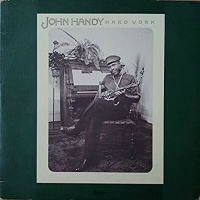 John Handy: Hard Work (ABC Impulse!, 1976)
John Handy: Hard Work (ABC Impulse!, 1976) After an almost ten-year absence from the recording studio, saxophonist John Handy assembled a small, eclectic ensemble for his return to vinyl. Along with musicians with backgrounds in Motown, Kansas City blues, funk bands, and jazz, Zakir Hussain's tabla found its first significant role in U.S. jazz (or more accurately, commercial jazz-funk). The title track developed a cult following that drove sales though the album was not critically lauded. Hussain did not contribute to that track but played on three of the seven numbers. Listen to his contribution on "Young Enough to Dream" and it is easy to hear how different a sound his tabla supplied more than forty-five years ago.
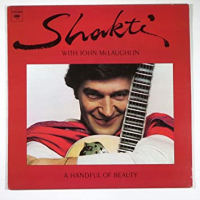 John McLaughlin and Shakti: A Handful of Beauty (Columbia/CBS, 1977)
John McLaughlin and Shakti: A Handful of Beauty (Columbia/CBS, 1977) John McLaughlin's Shakti is a pared-down formation with one less player than the debut album. The guitarist is joined by Zakir Hussain, violinist Lakshminarayana Shankar, and T. H. Vinayakram on ghatam, an ancient clay pot percussion instrument. Shakti's second album makes up for Ramnad Raghavan's lost energy with synergy. Shankar's violin does much to establish the subdued mood and his interplay with McLaughlin is incomparable. Hussain and Vinayakram provide a unique buoyancy pulling gently in all directions.
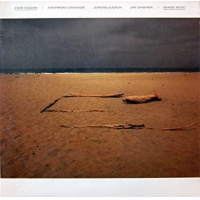 Zakir Hussain: Making Music (ECM, 1987)
Zakir Hussain: Making Music (ECM, 1987) The quartet of Hariprasad Chaurasia (flute), John McLaughlin, Jan Garbarek, and Zakir Hussain reject the fusion label on Making Music. They wind and circumvent a variety of ideas and allow the music to take its course. Even when Garbarek's saxophone injects a jolt of energy, or McLaughlin lays down one of his trademark riffs, the music remains light and ethereal. Making Music remains a benchmark recording of East/West fusion regardless of the artists' rebuffing the tag.
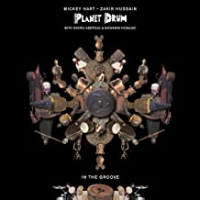 Mickey Hart/Zakir Hussain and Planet Drum: In the Groove (BFD, 2022)
Mickey Hart/Zakir Hussain and Planet Drum: In the Groove (BFD, 2022) Hart and Hussain have been the foundation of Planet Drum since 1991. With original members Sikiru Adepoju on talking drum and Giovanni Hidalgo on congas, bahia, timbales, and vocals, the core group is joined by eight additional percussionists in various combinations for In The Groove. The global nature of the group is reflected in the assorted rhythms of the album's six pieces. The project came out of the COVID-19 pandemic and Hart's wish to use the music as a vehicle for healing. The playing holds to a collective approach with little in the way of solos and as the title implies, it is all about the groove.
Comments
Tags
Under the Radar
Karl Ackermann
The Beatles
George Harrison
Ravi Shankar
Rolling Stones
Charlie Watts
Shelly Manne
Art Blakey
Roy Hayes
Max Roach
Billy Higgins
Paul Simon
Gabor Szabo
Manfred Schoof
Barney Wilen
Irene Schweizer
John Coltrane
Gary Peacock)) and saxophonist {{Bud Shank
John Mayer
Joe Harriott
Kenny Wheeler
john mclaughlin
Charlie Haden
David Liebman
Airto Moreira
Miles Davis
Bill Laswell
Pharoah Sanders
Ornette Coleman
Trilok Gurtu
Jan Garbarek
Peter Gabriel
Led Zeppelin
Jimmy Page
Robert Plant
Luciano Pavarotti
carla bley
andy sheppard
Geoff Williams
Manu Katche
Billy Cobham
Chick Corea
Gwen Laster
Dan Weiss
Rudresh Mahanthappa
Alice Coltrane
Grateful Dead
Mickey Hart
John Handy
Herbie Hancock
Tony Williams
Pat Martino
charles lloyd
Bela Fleck
Dave Holland
Chris Potter
Van Morrison
L. Shankar
Planet Drum
For the Love of Jazz
 All About Jazz has been a pillar of jazz since 1995, championing it as an art form and, more importantly, supporting the musicians who create it. Our enduring commitment has made "AAJ" one of the most culturally important websites of its kind, read by hundreds of thousands of fans, musicians and industry figures every month.
All About Jazz has been a pillar of jazz since 1995, championing it as an art form and, more importantly, supporting the musicians who create it. Our enduring commitment has made "AAJ" one of the most culturally important websites of its kind, read by hundreds of thousands of fans, musicians and industry figures every month.





